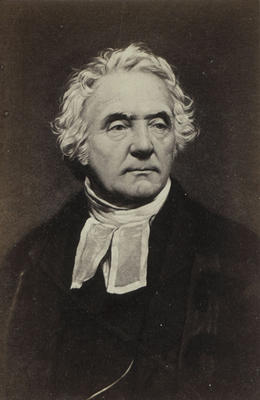
A Thomas Annan photograph of a portrait of Dr Thomas Chalmers (1780-1847). The painting was by John Faed.
Chalmers was educated at the University of St Andrews. In 1815 he became minister of Glasgow's Tron Church and from 1819-1823 he as minister of St John's Parish, including an over-populated area blighted by extreme poverty and of social deprivation to the east of Glasgow Cross. Chalmers believed in reviving and strengthening the role of the parish church in caring for the physical as well as the pastoral needs of the poor of the parish. At St John's he reorganised his deacons, elders and Sunday school teachers to form missionary teams, visiting parishioners, setting up schools and encouraging "moral" habits. Money from church collections was distributed by elders who were responsible for assessing need and judging how "deserving" were the recipients. The experiment met with limited success - the area's problems were too deep-rooted and widespread for the parish to cope with alone - but Chalmers inspired a generation of evangelicals with a missionary zeal to tackle the social problems of city centre slums.
Chalmers left Glasgow in 1823 to become Professor of Moral Philosophy at St Andrew's. He became the acknowledged leader of the evangelical wing of the Church of Scotland and was a Moderator of the General Assembly in 1832. Eleven years later, however, he led the famous 470 ministers who quit the church in protest at the exercise of patronage in the selection of ministers, and who subsequently founded the Free Church of Scotland.
Reference: Mitchell Library, GC 920.041435 COR
Reproduced with the permission of Glasgow City Council, Libraries Information and Learning
Keywords:
church elders, Church of Scotland, churches, deacons, evangelicals, missionaries, Free Church of Scotland, ministers, overcrowding, poor relief, portraits, slums, social reformers, St John's Parish Church, Sunday schools, The Disruption, Tron Parish Church, University of St Andrews
You have 4 images in your photo album.